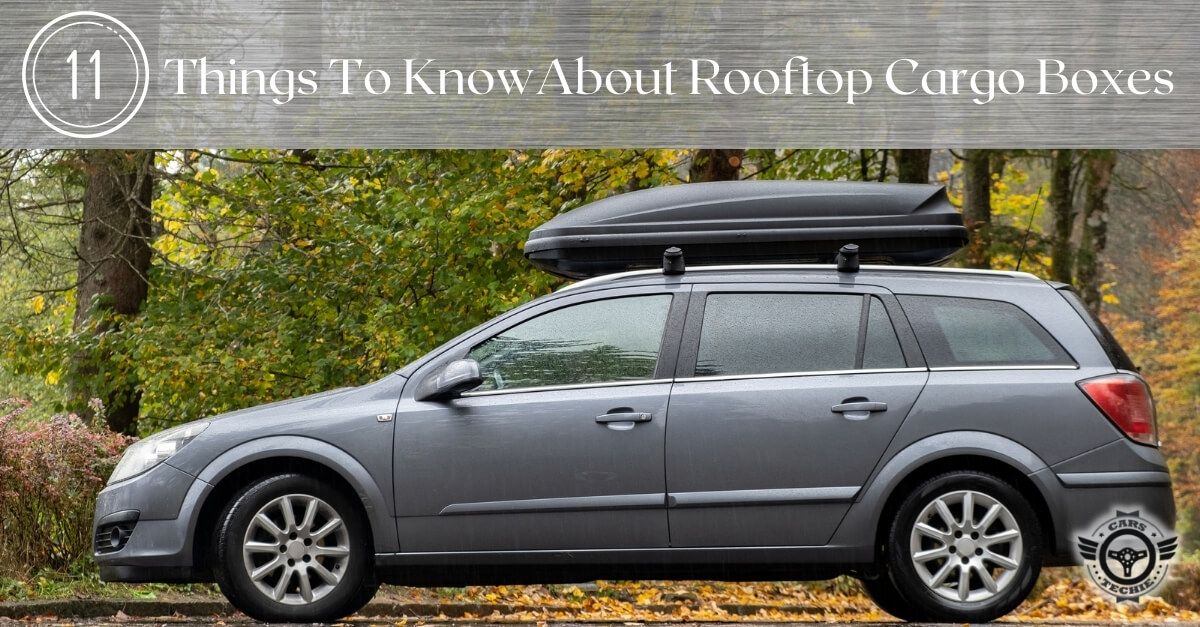Having a rooftop cargo box mounted on your car comes with a lot of conveniences and storage space! No hassles of packing everything inside the boot, and you can enjoy the road trip comfortably with your family and friends.
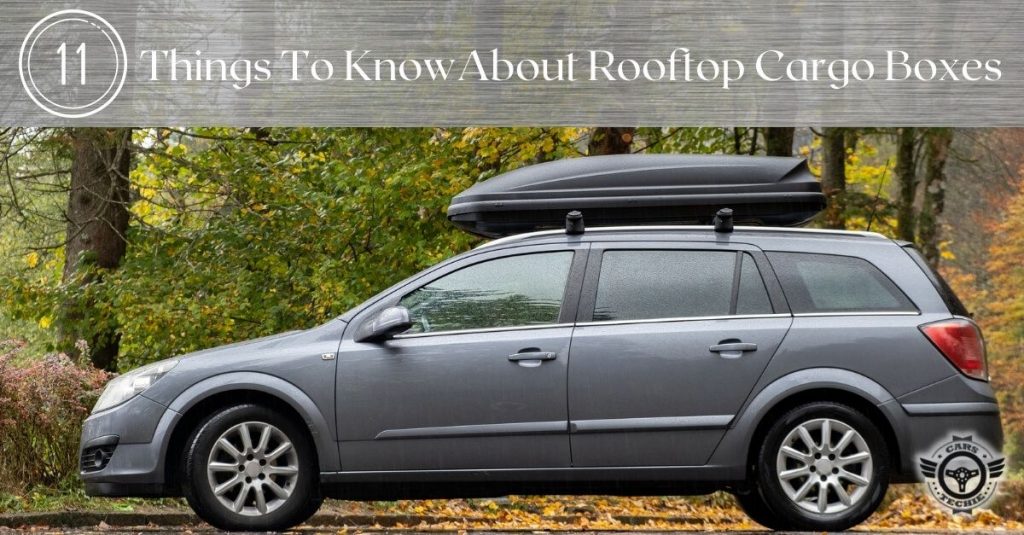
However, there are a few things to keep in mind after you buy a rooftop cargo carrier for your vehicle. You’ll notice several differences in the drivability, mileage, and weight of the car.
I’ve been using a cargo box for more than five years now, and here are 11 things I want you to know.
Contents (Jump to Topic)
Can you go Through a Carwash with a Roof Box?
Although it’s pretty easy to disassemble the rooftop cargo box, it can be daunting to do it every time you want to wash your car. Rooftop boxes are sturdy, durable, and can withstand almost anything, but does that mean you can enter any carwash with the box mounted on your car?
No, you should never enter a regular car wash without removing the cargo box. If it is a touchless car wash, where no brush rollers will touch the car or the cargo box, then you can go through the car wash provided the roof box is empty or is entirely waterproof. However, experts recommend removing the cargo carrier every time you want to wash your car.
Reasons to Avoid Entering a Carwash with a Cargo Box
Modern car washes are smart, and they do minimal damage to the vehicle. But there are high chances that water will enter the roof box wetting your gear or essentials packed inside. Furthermore, the strokes from the car washing brush can peel off the paint, or it can leave scratches in your new cargo carrier.
There are plenty of possible risks the cargo carrier may be exposed to if you go through a car wash. These include:
- Rusting of metal parts
- Snagging and scratches
- It can void the manufacturer’s warranty
- The carrier’s lid can get entangled with the washer rollers
- Damaging the carwash
How to Wash a Car Without Removing the Cargo Box?
So, you are on your way somewhere and don’t want to get into the troubles of removing the cargo carrier? Well, there’s great news! You can still wash your car and make it look pristinely clean.
Look for an Automatic Carwash
More and more companies are now installing automatic or touchless car washes in several states of the U.S. And you won’t have a hard time finding one.
These car washes just spray water and soap solution, and there are no rollers or any other objects touching your car. Make sure to empty the cargo carrier, as water may enter inside.
I would recommend these carwashes to people with a fully waterproof rooftop cargo box.
Hand Wash the Car

This one may need more time, but you don’t have to empty or remove the cargo carrier. Get a bucket, some liquid soap, and a sponge. It would be great to call someone to help so that you can get the dirt off the car quickly.
You can even go for the best pressure car washer to clean like a pro. This one is the safest practice to wash a car without removing the roof box.
Is the Carwash Company Responsible for Any Damages?
Not at all! No carwash company suggests entering the premises with a cargo carrier, so you cannot sue them if your new cargo carrier or car gets damaged.
In fact, the carwash company can ask you for a claim if the car wash equipment gets damaged due to the roof box. So, it’s better to remove the cargo carrier before entering the carwash.
Can You Drive With An Empty Car Roof Box?
So, you are back from the road trip and in a dilemma whether to remove the roof cargo box or keep it mounted? Well, mounting and unmounting a roof cargo carrier requires time and is a painstaking task if you have a regular cargo box.
Should I drive my car with an empty roof box? No, you should not travel with an empty roof box, as it possesses several disadvantages. Not only will you find it harder to maneuver the vehicle, but you will notice a mileage drop of up to 25%, as per Energy.gov. It would be great to remove the cargo carrier and store it in a safe place when you are not using it.
Downsides of Travelling with an Empty Roof Box?
There are several downsides of traveling on your daily commute with an empty roof cargo carrier. Well, the oncoming wind will cause issues, and you will find it hard to handle the vehicle.
Moreover, you’ll hear the increased noise levels, which may be disturbing while driving. Another disadvantage is that your car has some extra weight, so the low tire pressure can quickly result in a deflated tire.
Some people even complain that their cargo carrier banged into the garage door due to the extra height.
Furthermore, it affects the lifespan of the cargo box, and the harsh weather can quickly downgrade the material quality of the box.
Can’t Remove the Cargo Box? Do this to Drive Safely
Folks that love unplanned road trips, and cannot afford to remove the cargo carrier, should follow the below-mentioned practical tips. With these handy tips, you can drive with a cargo carrier mounted on the car.
Go for an Aerodynamic Cargo Box

Aerodynamic rooftop cargo carriers like the Thule Motion XT Rooftop Cargo Carrier are better for daily commuters. The design cuts through the air, so there will be less drag, less noise, and better fuel economy.
Inspect the Locks
Inspect the locking mechanism, and be sure it is tightly secured with the roof before hitting the roads. Sometimes, the lid of the cargo box opens due to the high air pressure, which can lead to accidents.
Check the Tire Pressure

If your car has a built-in tire pressure monitoring system, check it daily and be sure every tire has the right amount of air. Cargo carriers are heavy, so you should have a look at the tires regularly.
Measure the Height of Your Garage Door
Drivers that want the roof box to stay mounted on their vehicle should measure the height of the garage door to ensure smooth in and out.
Regardless of the type of rooftop cargo carrier you have, it is essential to follow the manufacturer’s recommendations as not doing that can lead to voiding the warranty. If the manufacturer doesn’t recommend driving with an empty box, don’t do it.
Using the car roof carrier properly is important to drive safely and enhance the lifespan of the carrier.
Do You Need a Special License to Drive with a Roof Box?
If you have bought your first rooftop cargo box, it’s natural to wonder whether you need a special license for it. Since driving with a trailer needs a registered license in the United States.

Do you need to register for a license when driving with a roof cargo carrier? No! There is no need to apply for or hold a special license to drive with a roof box. As per the RTO rules in the United States, people driving their cars with roof and hitch carriers don’t need any type of special licenses or permissions. So, you can drive wherever you want, with your luggage securely packed in the box.
Are There any Regulations for Speed and Weight?
The RTO has not specified anything regarding the weight and the speed. However, there are certain things to keep in mind when driving a car with a rooftop cargo box.
Pack 80% of the Total Capacity
Always pack 20% less luggage than recommended by the manufacturer. If the cargo box can accommodate 100lbs, you should only pack 80lbs, leaving some free space to easily unpack the luggage.
Packing the box up to the brim possesses several risks, such as it can damage the roof of the car, or you may encounter more rollover on the sharp turns.
Keep an Eye on the Speed Signs
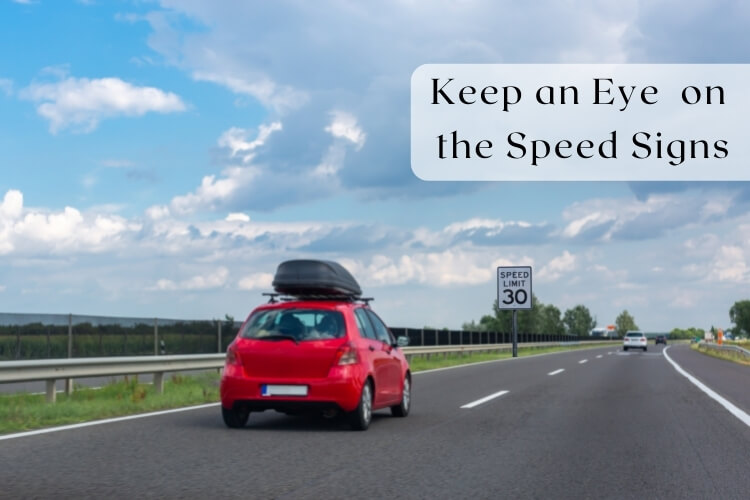
When driving a four-wheeler with a box mounted on the top, always adhere to the speed regulations. If the signboard says 90 miles an hour, you should go a little slower than the limit as the cargo box affects maneuverability.
Can Police Fine Me for Driving with a Cargo Box?
Yes, the police can pull you over and fine you if you do the following things.
Not Mounting the Box Properly
Not installing the rooftop cargo carrier properly can land you in trouble, and the police may fine you for risking your and other drivers’ lives. Inspect the cargo box properly before leaving for the road trip.
Overloading It
The traffic police can quickly determine if you have overloaded the box. Load the box properly and there shouldn’t be any protruding items like the snow skis or skateboards dangling on the top.
Can I Drive Anywhere with a Roof Cargo Box?
Nope! As per the law, there is nothing that states you cannot drive on a particular road with a roof cargo box. If it allows you to drive a four-wheeler, you can go on it with a box mounted on the top.
These include rural roads, interstate highways, city roads, and more. However, certain roads can have weight as well as speed limitations. So make sure to go through the RTO rules and regulations of a particular area before going on a road trip.
If you don’t find any clear-cut weight and speed limitations, get in touch with the local DMV office for more details.
How to Choose the Right Size Cargo Box?
Buying the right-sized cargo box can be pretty confusing, as there are several things to look for. While most cargo boxes appear the same, it doesn’t mean you can go for any of these and mount them on your car. So what size cargo box do I need?
Finding the right size cargo carrier depends on multiple factors, including the luggage and gear you want to carry and the type of vehicle you drive. If you drive a hatchback, you need a smaller carrier that leaves enough room for the boot door to open properly.
Quick Tips to Buy a Rooftop Cargo Carrier
Buying the right size is essential to have a smooth experience driving on the roads. Make a list of some cargo carriers, and compare them based on these factors.
Consider the Length
The length plays a critical role in determining the size of the cargo box. Furthermore, it depends on the type of vehicle you drive.
Long Cargo Boxes: Best for SUVs and Sedans
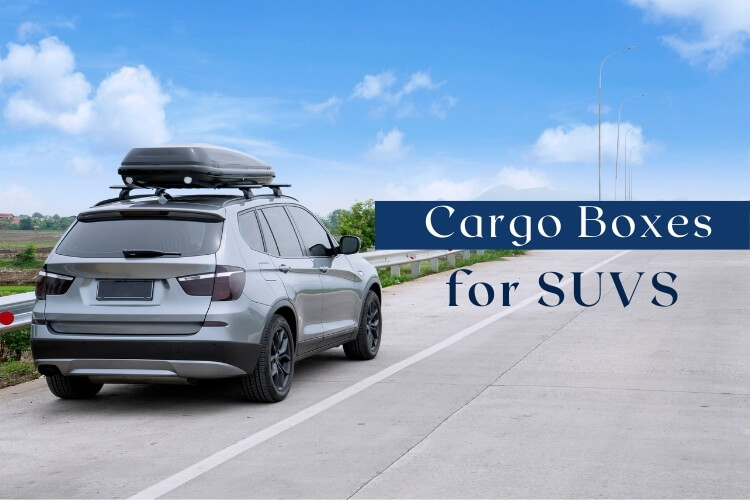
Long rooftop cargo carriers like the Thule Motion XT Rooftop Cargo Carrier are great for longer vehicles, including SUVs. These boxes have more capacity, more volume and are great for people planning to travel with friends and family.
Medium Cargo Boxes: Best for Crossovers and Sedans
Rooftop cargo carriers like RoofBag Rooftop Cargo Carrier have medium length and are ideal for smaller vehicles with less space available on the roof. These boxes offer decent storage for a family of two.
Small Cargo Boxes: Best for Hatchbacks
Small rooftop cargo carriers are great for hatchbacks. These small cars can only carry a lightweight and sleek cargo box. There are plenty of good boxes available, like the Thule Sidekick Rooftop Cargo Box.
Pay Attention to the Storage Space
Even if you own an SUV doesn’t mean you should go for a long cargo carrier. Check the storage space and ensure the box can accommodate your gear and luggage with ease.
If you want to travel with your ski, winter clothing, and other essentials, a cargo carrier with a bigger capacity would be great. On the other hand, if you have limited luggage, choosing a smaller box will be a wise choice.
Be Sure About the Width
Choosing the right width is as essential as choosing the length. The cargo box should be less wide or equally wide to the roof rails of the car. A less wide box ensures better aerodynamics, and it won’t affect the car’s mileage that much.
Measure the width of the roof rack, and then look for a cargo box to buy the right size.
Aren’t Bigger Cargo Boxes Better?
I come across a lot of car drivers that believe that bigger boxes are always the best. But that’s not the case. Choosing a bigger or not choosing the right-sized cargo carrier can have the following disadvantages:
Bigger Impact on Fuel Economy
If you go for a bigger and wider cargo box, expect to see a sudden downfall in the fuel economy. This is caused by the heavyweight of the box and more drag caused due to air.
Bigger Noise
As a big surface will hit the air, it will produce more noise that will be audible inside the cabin. If you love a quiet and comforting ride, you should choose the roof cargo box size wisely.
Bigger Boxes are Cumbersome
Handling a bigger cargo box can be problematic when you unmount it from the car and take it for storage. Watch out for the available storage space, and then choose a box that will fit easily and securely in the garage.
How to Pack a Rooftop Cargo Box?
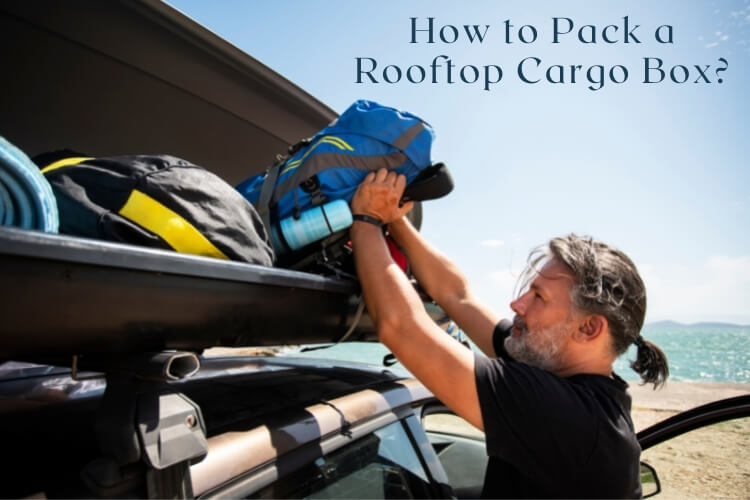
Packing the rooftop cargo box properly is an art, you can easily master it, so stop worrying! It is essential to pack all the stuff evenly so that the box remains secure on the car and doesn’t create any difficulties while driving. Here’s how to pack a roof cargo box like a PRO.
- Understand the weight limit and don’t exceed it
- Put the big items below
- Spread the weight evenly
- Don’t pack any loose items
- Pack the heaviest items in the car’s boot
- Use the straps, hooks, and holder to get extra space
Let’s take a look at all the above points in detail:
Understand the Weight Limit and don’t Exceed It
Check the manufacturer’s label and know the weight limit of the roof box. If the box says it can carry 100 lbs, you should only pack 80 lbs of luggage to stay under the safe limit. This is an important hack for packing the box properly.
Put the Big Items Below
The big items like the tent or the suitcase should be below the smaller luggage items. The items you won’t frequently be using or you only need them after reaching the destination should be at the lowest level.
Spread the Items Evenly
Spreading the items evenly will help you get more free space while you don’t have to worry about the car’s tire pressure. Also, you’ll see uniformity inside the roof cargo box, and the luggage will look neat.
Don’t Pack any Loose Items
As per road trip enthusiasts, you should not pack any loose items in the roof box. These items will move as you accelerate and brake, so it can damage the cargo carrier, or the items may also get damaged.
Pack the Heaviest Items in the Car’s Boot
Roof cargo boxes aren’t designed to carry heavy loads, so pack the heavy items, including the big suitcases, inside your car.
Use the Straps, Hooks, and Holder to get Extra Space
Smart packers always use the hooks and holders to utilize more space. If you are travelling with skis and snowboards, you can mount them on the cargo box properly using bungee ropes.
Things to Keep in Mind When Packing a Roof Cargo Box
You have to be careful while driving with a fully loaded cargo carrier since you have 100-120 lbs more weight on the roof. Keep the following things in mind, and drive safely to your destination.
Don’t Overload
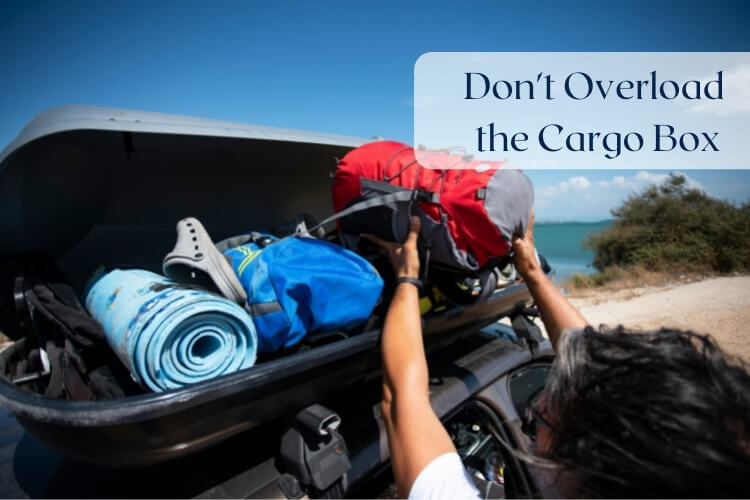
Never overload the cargo carrier, as it will have an adverse effect on the box’s life, whereas the mechanism connecting the box with the roof rails can also get damaged.
Drive Slow
Always drive slowly when you have a fully-loaded roof cargo box mounted on your car. Going slowly will help you apply the brake easily, and it’ll protect the luggage as well from smashing against the carrier.
Be Careful at the Turns
Heavier boxes tend to increase the center of gravity of the car, so you will experience some rollover. Get slow and careful while crossing the sharp turns.
How Fast Can You Drive with A Roof Box?
The best rooftop cargo carriers like the Thule Motion XT Rooftop Cargo Carrier have got an aerodynamic design that slashes through the air and helps you drive faster. But how fast can you go with a fully loaded or empty roof box mounted on the car?
As per Thule, a vehicle with a roof carrier should not exceed 80 MPH under any circumstances. However, the RTO has not specified a particular speed limit, so you have to drive according to the speed and traffic regulations of the particular area.
Exceeding the speed not only attracts several penalties, but it increases the chances of accidents.
Safety Tips When Driving Fast with a Rooftop Cargo Carrier
If you have decided to drive fast but under the limits, here are a handful of tips that’ll help you get better control over the steering wheel.
Go for an Aerodynamic Roof Box
If you are looking for a roof cargo carrier, go for one with an aerodynamic design. The lesser the drag, the better will be the vehicle’s maneuverability.
Pack Wisely
To prevent a severe impact on the braking system and the steering wheel, you should pack the luggage wisely. Distribute the weight evenly, and ensure there are no loose items inside the box.
Putting heavier items on the top will make it difficult to drive the car at high speeds.
Utilize Cargo Anchors
If you don’t want the box to fly off at higher speeds, take some help from cargo anchors. These anchors hold the box in place and keep the lid securely closed. You can use bungee ropes and other anchors to do the job.
Check the Tire Pressure
The tires should have the right pressure, as a rooftop cargo box is heavy with the load packed inside it. Keep monitoring the tire pressure after some time to ensure none of the wheels is deflating.
Maintain the Visibility
Install a cargo box in a way that doesn’t block the visibility. You have to keep your eyes everywhere when driving at high speeds with a roof box on the top. Make sure no obstacles are blocking the front and rear windshield.
Also, defrost the windshield quickly to get better visibility.
Importance of Driving Under Speed Limit with a Roof Cargo Carrier
Driving under the speed limit not just saves you from a heavy fine, but it has several other benefits as well. If you drive the car around 80-90 miles per hour, you can enjoy a more stable ride with guaranteed safety.
It Enhances the Life of the Suspension and Tires
Driving under the limit helps the suspension bear less wear and tear while crossing the bumps. Similar is the case for the tires.
It Prevents Accidents
Driving a car with a roof box is different from driving a car without it. So, there are fewer chances of accidents if you drive the four-wheeler carefully and under the speed limit.
It Improves the Lifespan of the Roof Box
High speeds can lead to the roof carrier’s lid opening accidentally, and it may fly off, resulting in a damaged cargo box. When you drive slowly, you can carefully cross obstacles, while strong wind won’t damage the carrier.
How to Reduce Roof Box Noise?
Rooftop cargo boxes for cars are convenient and enhance the luggage-carrying capability of your vehicle. However, driving at high speeds can result in loud noise caused due to the drag of the air. How do I reduce the roof box noise? Follow these tips, and you can drastically reduce the noise.
- Use an aerodynamic rooftop cargo carrier
- Pad the crossbars
- Remove the roof box when not using it
- Use a wind deflector
- Install aerodynamic crossbars
Let’s take a look at all the above points in detail:
Use an Aerodynamic Rooftop Cargo Carrier
If you are planning to upgrade your roof cargo carrier, invest in an aerodynamic one. The design will cut through the air, and there will be less noise than before.
Pad the Crossbars
Padding the crossbars will help to curtail the wind drag against the metal parts, and it will help in reducing the noise. You can wrap a cloth around the crossbars and tape it so that it remains securely in place at high speeds.
Install Aerodynamic Crossbars
This one is a sure-shot way to get rid of the wind noise. You should use a combination of an aerodynamic roof cargo box and crossbars to bring the noise to the lowest levels.
Remove the Roof Box when not Using it
This is the best solution to reduce the noise to zero. If you are not using the cargo carrier, unmount it, and drive your car without any noises.
Use a Wind Deflector
There are several wind deflectors available in the market that can help in reducing the noise. Attach the deflectors to the crossbars so that the wind will prevent the air from striking against the smooth surface of the crossbar or roof rack.
Using these tips will surely help in reducing the noise up to a great extent. Test ride the vehicle at a good speed to figure out if the hack you have used works or not.
Why Is My Car’s Roof Box Noisy?
There are several reasons why you hear a whistling noise when driving a car at high speeds. Some people even complain about loud clicking and banging noises from the roof box. It is important to learn why the carrier is noisy in order to reduce the noise.
Loose Items
The banging noise that you often hear while braking or accelerating is due to the loose luggage inside the rooftop cargo box. These items brush against the sidewalls, and this causes loud noises.
Make sure there are no loose items inside the cargo carrier and everything is packed evenly.
Protruding Elements
The hooks, ropes, and other protruding elements on the rooftop cargo carrier can also cause a lot of noise while driving. These elements strike against the plastic or fiberglass box to generate noise.
The Wind Drag
This is the common cause behind the whistling noise. It is due to the air crossing through the small gaps between the cargo carrier and the roof rack/rails. The noise can be louder sometimes, depending on the speed of the car and the speed of the wind.
Do Roof Racks Damage Your Car?
Using car roof racks is pretty convenient while traveling with your family on a road trip. However, there are several cases of these racks damaging the car’s roof partially or entirely.
Does using a roof rack damage your car? No, there won’t be any damages to the vehicle provided you have installed the rack properly. An overtightened or overloaded roof rack can be hazardous, so always use it by referring to the vehicle manufacturer’s instruction manual.
How Do Roof Racks Damage Your Car?
There are multiple ways a cargo rack can damage your vehicle, and this is entirely due to not installing and using it properly. Some drivers drill holes on their cars in order to install the rack, and it can lead to damaging the roof and weatherstripping.
Another common damage a rack can cause is when you overload it. The load gets distributed on the pillars of the cars, and they become weak with time.
Tips to Avoid Any Damages to the Roof When Using a Roof Rack
These tips will help you drive with ease and use the cargo roof rack to its full potential. Moreover, there are fewer or no chances of voiding the warranty.
Let’s have a look:
Read the Instructions Carefully
I understand there are plenty of roof rack DIY installation guides available to make the task easy, but it is essential to skim through the instruction manual before you start with the installation process.
Take Some Help While Installing It
It is the right time to call your local mechanic and get some assistance while installing the roof rack.
Don’t Drill Holes
Never drill holes on your car if there are no roof rails. Figure out a different idea to install the rack, and stay away from doing anything that can ruin your vehicle.
Don’t Overload

Another reason a roof rack can damage your car is due to overloading it. Always utilize the 80% weight capacity of the rack, and spread the weight evenly to protect your vehicle.
Does a Roof Box Need to Be Central?
Rooftop cargo carriers can make your journey easier if you are traveling with heavy luggage. Not only does it reward you with extra space inside the car, but the carrier keeps the luggage secure at all times. However, installing a roof box can be a little problematic, as some people believe it should be centered, whereas some say you can install it on either side.
Does the cargo box need to be centered? No, you can mount the cargo box on any side you want. However, make sure the box is balanced and the load gets distributed to every tire. Experts recommend installing the roof carrier in the center unless you have a reason not to do so.
Do I Need Roof Racks for Installing Cargo Box?
Yes, roof bars/roof racks are very important when installing a cargo box. The rack keeps the cargo box stable, whereas it provides good height to the carrier, and it doesn’t damage the vehicle’s roof.
Another reason for using a roof rack is the extra security you get for the carrier. If your car doesn’t come with racks, you can get them installed at your nearest car dealership.
How to Find Out the Perfect Spot for Installing a Roof Box?
If the roof box doesn’t have to be in the center, where should I install it? Well, it is important to find the perfect spot for installation so that the cargo carrier remains securely in place and you can drive to the destination with ease.
Here are some tips that’ll help you:
Check the Tire Pressure
Keep an eye on the tire pressure after placing the box on the rack. If one tire is bearing more load than the other three, you have to change the box’s position. All tires and suspensions should get an equal load for a smooth ride.
Go for One that’s Made for Your Car
If you own an Audi Q7, there’s no chance you can fit a cargo box designed for Mini Cooper. Always look for cargo carriers designed for your vehicle type.
The Box Should Not Touch the Roof
If installing the box at the center touches the roof, you can change the position. There should be at least a 2 or 3-inch gap between your car’s roof and the cargo box’s base.
The Opening Lid Should Be Accessible

Install the cargo box in a way that the lid is accessible, and you can pack/unpack the luggage as required. If the box requires you to lean over the car while standing on a wooden stool, you need to correct its position.
If you are not sure about the exact position the cargo box should be, ask any local car mechanic to help you out. Or watch some YouTube videos on how to align the cargo carrier properly.
How to Store Roof Box Safely in the Garage?
A rooftop cargo carrier is not small, so you cannot store it just anywhere. Moreover, it requires more space for storage if you want the cargo box to remain in good shape. Knowing how to store the roof box is essential for every owner.
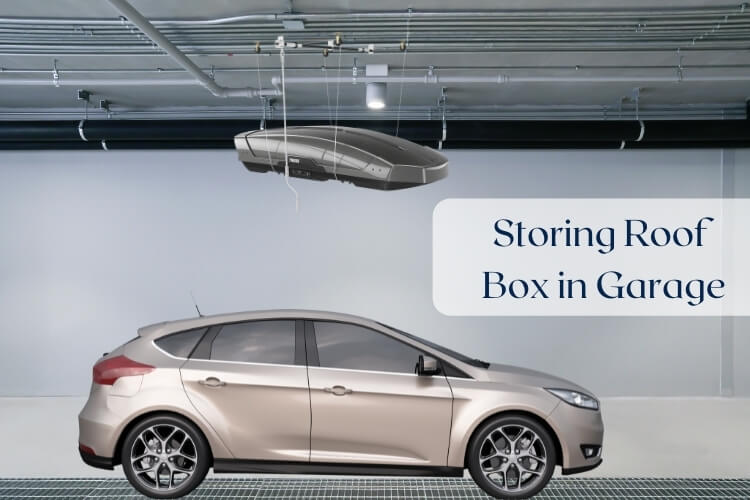
So, how do I store the rooftop cargo carrier safely in the garage? The best way to store a roof cargo box is using a storage system or a storage shelf. You can store the box for long periods of time without worrying about any damages caused due to scratches or the carrier falling on the ground.
Importance of Storing the Roof Cargo Box
There are plenty of solid reasons why storing the roof cargo box is a real deal. If you leave the box installed on the car, there are high chances of it getting damaged due to the regular wear and tear.
Also, you have to compromise with the vehicle’s mileage. Another reason to store it is better drivability and less wind noise.
Tips to Store the Roof Box Securely in Garage
Storing the cargo carrier should be done carefully so that it does not bang against anything inside the garage. Here’s how I store my rooftop cargo carrier when not using it.
Clear Some Space Inside the Garage
Some rooftop cargo boxes can be as long as 5 feet or even more, so you need space to carry them around inside the garage. Declutter the garage and make good space for the carrier and the storage box or shelf.
Find a Perfect Spot
If you have no plans of using the cargo carrier for the next two months, you should store it somewhere at the back of the garage so that the frontal space remains vacant for other items.
It would be great to take a measuring tape and then find the spot that matches the dimensions of the cargo carrier.
Install the Wall Cargo Box Shelf
If you are handy with a drill and are confident, you can do the job, drill some holes in the wall and hang the shelf. Now put the roof cargo box securely on the shelf.
Cover It with a Cloth
Cover the entire roof box with a thick canvas cloth so that there is less or no dust accumulation. Make sure to take out the keys and never store them inside the box.
Using a storage shelf is the easiest way to store a cargo carrier. If there is limited space in your garage, try a ceiling storage hoist and hang the box securely with it.
Can I Put a Roof Box on a Panoramic Roof?
Cars with sunroofs are classy, not just you can enjoy the cool breeze, but also it lets more natural light in, which makes driving even more fun. However, such car owners are always confused when it comes to installing a roof box.

Can I install a roof box on a panoramic sunroof? Yes, you can! However, it depends on the size of the sunroof and the size of the cargo carrier. It is essential to use good-quality roof bars that can hold the roof box in place. Also, you should get in touch with the vehicle manufacturer to know if using a roof box voids the sunroof’s warranty.
How to Choose a Rooftop Cargo Carrier for a Car with a Sunroof?
There are multiple things to consider before installing a roof cargo box on a panoramic sunroof. The essence of these factors is to help you do the installation correctly without damaging the sunroof’s glass.
Read the Instruction Manual
It’s time to dig out the vehicle’s instruction manual from your garage’s storage. Read the sunroof section, and you will surely find something related to using a cargo carrier. If the manufacturer states that you can use a roof rack, you are good to go.
Consider the Weight Capacity of the Sunroof
The weight capacity of the sunroof is less than a regular metal sheet roof. So be sure about the weight the glass roof can handle. Look for cargo carriers that fall below the weight capacity of the sunroof.
Mind the Glass
The cargo carrier should not touch the sunroof in any way, as it may damage or scratch the glass surface. I recommend hard-shell rooftop cargo boxes because they don’t have any protruding parts and remain on a certain height from the sunroof.
Install Roof Bars
If your car doesn’t have roof bars, you should get them installed to use a cargo carrier. Contact your nearest car dealership to know more about the roof bar installation.
Handy Tips When Driving with a Cargo Box Mounted Over the Sunroof
One of my friends owns a Jeep Grand Cherokee, and it has a huge panoramic sunroof. We used a rooftop cargo box on our last road trip to Miami, and here’s what I learned.
Don’t Open the Sunroof with the Box
It would be best to drive the vehicle with the sunroof closed until you remove the cargo box. Opening the sunroof can lead to a lot of air entering the car. The air strikes against the aerodynamic cargo carrier and enters straight into the vehicle.
You can open the sunroof’s shade, but keep the glass closed.
Remove the Cargo Carrier When Not Using It
If you have no plans of going on a road trip for the next few months, remove the cargo carrier, and protect the sunroof.
Get it Installed by Experts
We called the Jeep dealership and got our cargo carrier installed. Installing such things on a car with a glass roof is pretty daunting. So, you should take assistance from the experts.
Wrapping Up
Rooftop cargo carriers are a boon for people that love going on road trips. You can easily manage the luggage while your car has ample free space to sit and relax.
These are the eleven essential things every rooftop cargo box owner should know. I’ve been using a cargo box for years, and I’ve covered almost everything in this post to make your journey smooth and easy.
Got any more questions in mind? Drop them in the comments section, and I’ll get back to you shortly with a satisfactory answer.
Last update on 2024-04-23 at 21:00 / Affiliate links / Images from Amazon Product Advertising API

